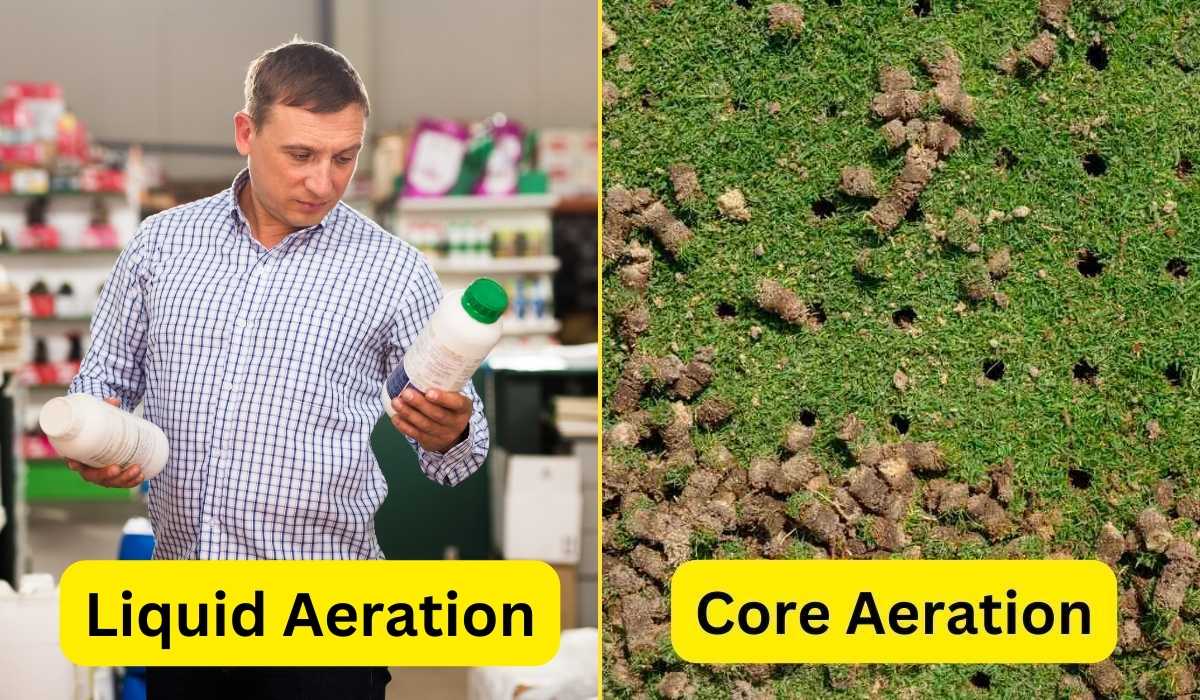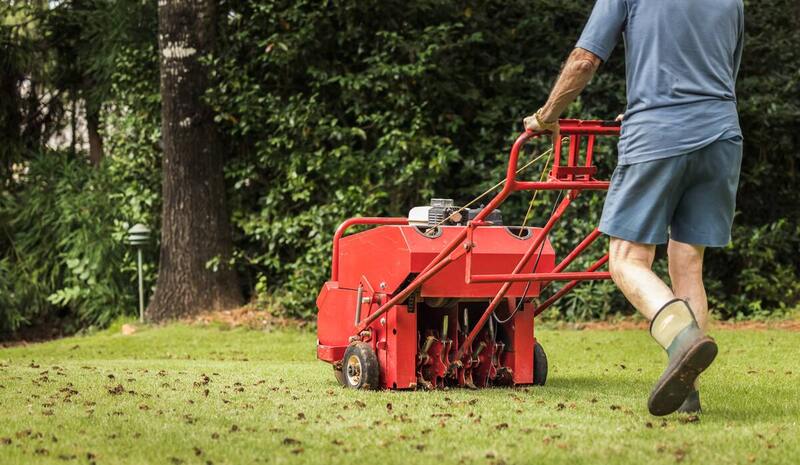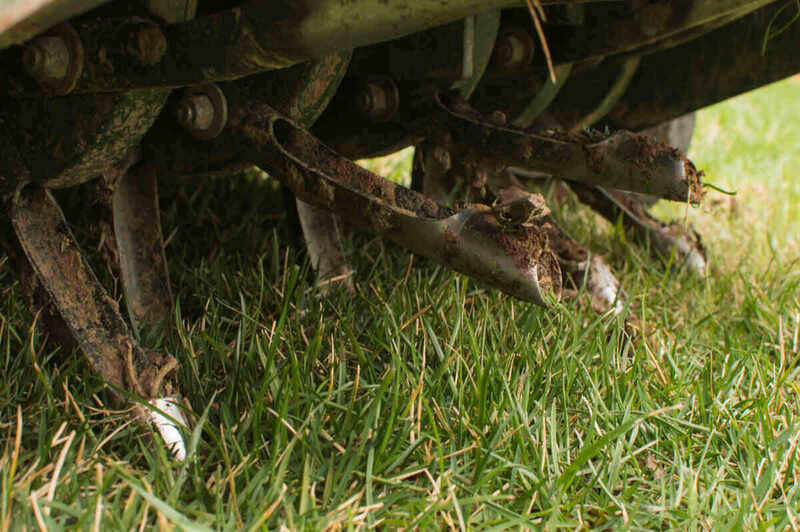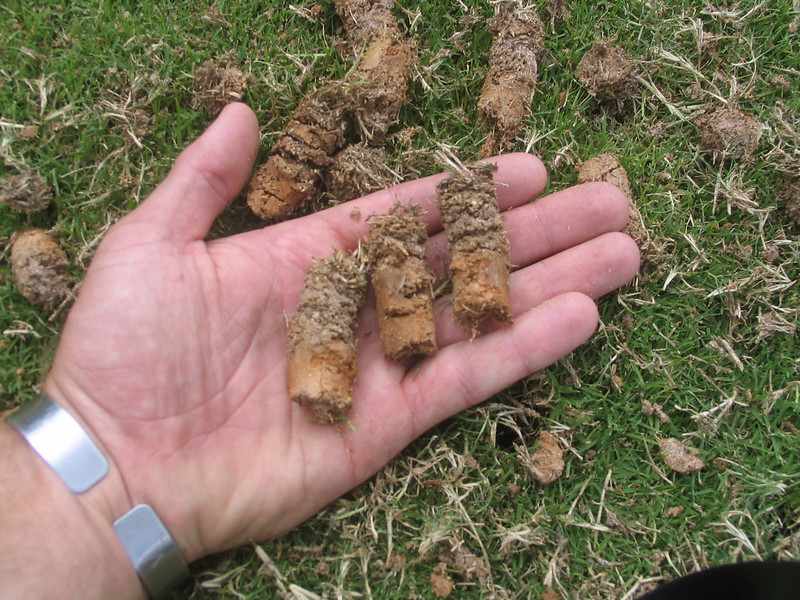
Aeration breathes new life into your soil. But what’s the difference between liquid aeration vs. core aeration? Liquid aerators lack scientific backing, while core aerators provide evident results.
Core aerators have hollow tines that remove plugs of soil to introduce more oxygen and nutrients to the grass roots. Liquid aerators are intended to loosen the soil through microbial activity. However, many professionals cannot confirm that liquid aeration products truly work.
We’ll expand on the two aeration methods, along with their key differences and follow-up treatments, such as overseeding.
What Is Liquid Aeration?
Liquid aeration products offer a chemical solution that breaks down the compacted soil through increased microbial activity. The intended purpose of the product is to allow more water and nutrients to penetrate the soil to encourage healthy grass development.
Liquid aeration is time-friendly, doesn’t require expensive equipment, and won’t leave soil plugs on your turf’s surface. However, results are less reliable than core aeration.
Liquid products are applied using a garden pump sprayer or hose-end sprayer. Water is combined with the chemical product, allowing you to spray the solution freely across your lawn.
The primary ingredients of liquid aeration products are humates (liquid organic matter) and soap-like materials such laureth sulfate.
Does Liquid Aeration Work?
In short, it is unclear whether liquid aeration works. Though wetting agents may improve moisture absorption, liquid aeration’s impact on soil compaction has not been scientifically researched.
In other words, liquid aeration products haven’t been properly evaluated for effectiveness. For this reason, most experts stick with mechanical solutions, such as core aerators, to counter soil compaction.
What Is Core Aeration?

Core aeration is an effective technique that relieves soil compaction, prevents thatch build-up, and improves water and nutrients movement in the soil. Core aerators use hollow tines to remove soil plugs from the ground as they move across the lawn. The air pockets created will increase water and nutrient availability in the soil.
Does Core Aeration Work?
In short, yes. Core aeration is a highly-rated technique endorsed by lawn care experts. Soil plug removal will unquestionably allow more nutrients and water into the soil. When performed correctly, core aeration will rid your lawn of brown, dull-looking patches.
Liquid vs. Core Aeration: Key Differences

Several factors distinguish liquid aeration from core aeration, such as the best application time. Let’s explore these differences below to help you pick the right measure for your lawn.
Treatment Type
Liquid aeration is a chemical process involving liquid products and a sprayer. It stimulates microbes present in the soil to gradually reduce compaction.
In contrast, core aeration is done mechanically with an aerator. No matter the type of aerator you choose, core aeration requires more physical effort than liquid aeration.
Want to perform core aeration on your lawn? Browse through our quick guide to core aeration for helpful tips.
Result Timescale
Liquid aeration products don’t provide immediate results. The chemical reaction may take anywhere from two weeks to one month to yield effective results.
Speaking of which, core aeration results are immediate. Removing soil plugs will effectively reduce soil compaction and prepare your soil for further treatments, such as fertilizing and topdressing.
Treatment Time
Liquid aeration is the clear winner here. Although it takes much longer for results to show, liquid aeration is generally less time-consuming than core aeration. Core aeration typically takes a larger chunk of your free time.
Surface Area Covered

Liquid aeration is more effective on small-to-medium sized lawns with moderate soil compaction. The bottle sizes vary depending on the brand and should be sufficient for more than one application. Generally speaking, you’ll need to spray about one ounce of the product per thousand square feet.
Large lawns with moderate to severe compaction require the immediate results of core aeration. You’ll need to pass the entire lawn with the aerator to create the required amount of holes in the soil.
Turf Stress and Appearance
Liquid aeration is simply spraying the grass blades, so you won’t be putting your lawn under any stress. Your lawn’s appearance won’t change after spraying the liquid product.
The same cannot be said for core aeration. Soil plug removal can do a number on your lawn, which is why it needs special care after aeration is complete. The soil plugs may look unappealing for a week or two, but will eventually break down to release nutrients back into the soil.
The Experts’ Choice
This is arguably the most important difference between liquid and core aeration. Core aeration is the experts’ choice as the tried-and-tested method for reducing soil compaction.
As mentioned earlier, liquid aeration products aren’t scientifically tested, so there’s no definitive answer to whether or not it effectively reduces soil compaction. You may get lucky for minor levels of compaction, or it may be a waste of time and money.
FAQ About Liquid and Core Aeration
What are clear-cut signs your lawn requires aeration?
Your turf will communicate with you and show signs of a compacted soil. Here are the main ones to look out for:
- Your lawn endures heavy foot traffic on a regular basis, causing the turf to thin out
- Water puddles form after rainfall (due to poor drainage)
- Your grass is developing brown patch or other lawn diseases
How can you tell that your lawn needs core aeration?
Soil compaction may not be too obvious, especially in the early stages. When in doubt that aeration is necessary, remove a square foot section of a suspected area measuring at least 6 inches deep. If the grass roots only extend into the first 1 or 2 inches during peak growth season, then your soil could benefit from core aeration.
How much does it cost to rent an aerator?
You can take the DIY route and rent either a spike or core aerator. The cost of renting a core lawn aerator is approximately $98 per day, while renting a spike lawn aerator costs about $54 per day.
On the other hand, professional aeration costs between $78 and $238 on average.
No Time to Mow? Hire a Pro
Liquid aeration seems easy, but it’s not recommended by most lawn experts. Core aeration is the best mechanical treatment, even overtaking spike aeration. The holes created by the aerator’s hollow tines allow more oxygen, nutrients, and water to reach the grass roots.
After core aeration, your grass will grow at a speedy rate. Hire a local lawn care pro to mow your well-established turf to its optimum height.
Main Image Credits: BearFotos / Shutterstock | Oldboys / Shutterstock, created using Canva Pro